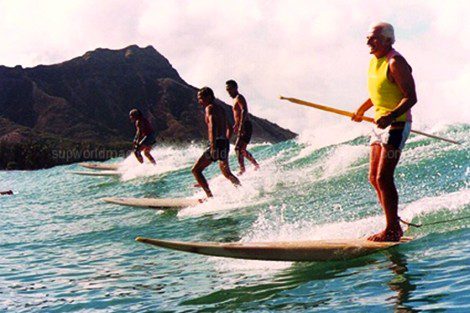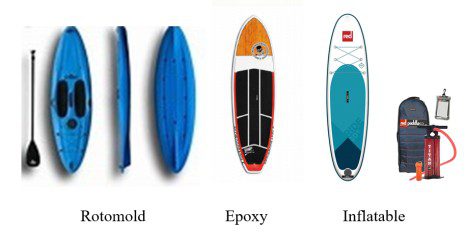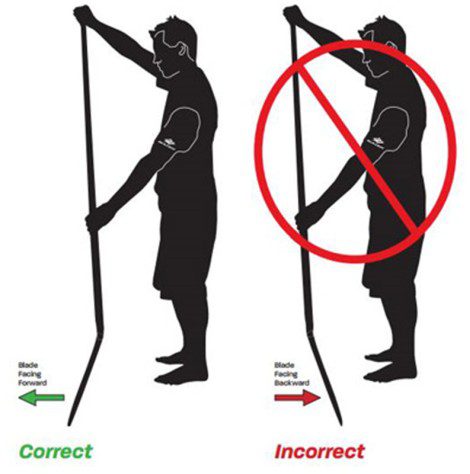 By Bob Currie, Recreational Boating Safety Specialist
By Bob Currie, Recreational Boating Safety Specialist
U. S. Coast Guard Auxiliary Station Galveston Flotilla
Did you know that the US Coast Guard regulates stand up paddle boards (SUPs) as boats? Let’s look at what this means for the average SUP rider.
Growing up on the Texas Gulf Coast, I always had a surfboard. We drove to school with our surfboards on the roofs of our cars, and as soon as school let out we headed to the beach. But we paddled out into the surf while lying down on the board, and we wouldn’t have thought of carrying a paddle with us. Things have changed. Although I still see some surfboards at my home beach, I see more stand-up paddle boards, also known as SUPs. Apparently this is a trend everywhere, and the US Coast Guard has taken a great interest in these boards. Why? Because SUP drowning accidents are on the increase disproportionately from all other forms of recreational boats.

Humans have been standing up in small watercraft for centuries. Records of early forms of stand-up paddle boards date back to as early as 1000 BC. Modern SUP originated in Hawaii as an offshoot of traditional surfing. Surfing instructors would take paddles on their boards and stand up so they could see the surfers under their instruction as well as the incoming swells. They would surf the waves using their paddles to steer their boards and use the paddles to move on the water when no wave was conveniently available to propel them. Stand-up paddling was strictly a Hawaiian thing until Rick Thomas brought a board home to California in 2004, and they really took off. As a true indication that stand-up paddling has arrived, the US Coast Guard classified SUPs as vessels like canoes and kayaks, and further required SUP riders to carry or wear an approved personal flotation device (PFD) when paddling in certain areas outside the surf zone.
SUP Materials
SUP boards are constructed with a variety of materials, and most technology has been carried over from surfboard or kayak construction techniques. The three basic materials are:
- Rotomold: have a durable plastic exterior and a hollow interior. They are relatively inexpensive, but they are also heavy.
- Epoxy: shaped in EPS foam (expanded polystyrene) and wrapped in fiberglass or other composite material. EPS foam absorbs water, so cracks can be a problem.
- Inflatable: made of PVC with drop-stitch construction. They are extremely durable and buoyant. Must be inflated to the proper PSI (usually 15-20 PSI).

SUP Paddles
The most crucial part of choosing a paddle is getting the right length. A paddle that is too long will tire your arms as you hold them up too high. A paddle that is too short will stress your back as you bend forward to reach the water. Paddle length greatly depends on the type of paddling you intend to do. Generally speaking, your paddle should be 10-12 in. taller than you for racing, 8-10 in. taller than you for cruising on flat water, or 6-8 in. taller than you for surfing. Adjustable paddles have a shaft that can extend and lock in different lengths. If more than one person is going to use the paddle, then an adjustable shaft will suit you well. Adjustable paddles are perfect for families, lake houses, and demo fleets. Adjustable SUP paddles will be marginally heavier than the non-adjustable paddles. The best paddle is one made to fit you. A custom-length paddle is produced longer than you need and then cut in-store and the grip glued into place.
SUP paddles have different size blades. Paddles are divided into two main groups: paddles for surf and paddles for cruising/touring. A surf paddle blade has a larger surface area for extra leverage against the water. Surf paddles are great for bracing and can also be used for white water SUP and SUP racing. A cruising SUP paddle blade has a smaller surface area which puts less stress on the arms while paddling long distances. There are also mid-sized paddle blades which fit the widest range of paddlers and work well for both surfing and touring. Carbon fiber is the lightest and strongest material used in paddles. A lightweight paddle will cause less arm fatigue, especially on longer trips. If you spend a large amount of time on the water, the weight savings of a carbon fiber paddle may well be worth the extra expense. Used for both shafts and blades, fiberglass is stiff, light, and provides a great balance between value and performance.

SUPs and the Coast Guard
The U.S. Coast Guard (USCG) has determined that SUP boards operated outside a surfing, swimming or bathing area are “vessels” under USCG regulations. The following refers to what that means for you when you are outside those areas.
Life Jackets:
- Each paddler 13 years of age or older must have a USCG-approved Type I, II, III, or appropriate Type V life jacket. It doesn’t have to be worn, although that’s certainly the wisest plan, and one which we strongly recommend.
- A child 12-years old or younger must wear their USCG-approved life jacket.
- The jacket must be in “serviceable condition,” without rips, tears or deterioration that will diminish its performance.
- The jacket must be of an appropriate size and fit for the wearer.
- A Type V jacket can be used as long as it’s USCG-approved and applicable for the activity.
- Belt pouch-type inflatable PFDs, must be worn on the person to meet the life jacket regulation. For other types of inflatable PFDs, check the approval description printed on the unit for restrictions.
- For all life jackets, be sure to read the label to know if special requirements pertain to that device.

Other Required Gear:
- A whistle or other sound producing device must be carried to warn other boaters.
- If you’re on the water after sunset, you need to have a flashlight, or similar lighting device, to warn other boaters.
What You Need to Do:
- As the operator of a vessel, you need to follow the Navigation Rules.
- You are also required to report any boating accident or injury to the local reporting authority, either the USCG or other agency that has been delegated that authority.

So, if you have this gear and follow these rules you should be legal under USCG regulations. State and local agencies may have additional rules or more restrictive versions of the federal ones. At this time, only personal watercraft (jet skis) require all persons on board to wear a life jacket, but that could change. Why wait for it to become a law? The only way a life jacket can work is when you are wearing it. I had one boat operator argue with me that he didn’t need a life jacket because he was a world class swimmer. I asked him how well he swam while unconscious. Just one small tap to the back of your head by your SUP is all it takes to put you into that advanced class of swimmers.
Summary
The Coast Guard regulations kick in outside the surf zone. So what is the surf zone? When trying to answer this question, I remember the judge who was trying a pornography case. He was asked to define pornography. He said he didn’t have a concrete definition of pornography, but he knew it when he saw it. The best way to describe surf zone is an area close to the beach with breaking waves that could be used for surfing. So, for SUP riders, your safest bet is to wear a life jacket at all times and carry a whistle. Those of you who watch old Mannix or Rockford reruns know that both of these guys get “knocked out” at least once per episode. It is always from a blow to the back of the head. This may be one of the most accurate displays of being knocked out. It just doesn’t take that big of a blow to make you unconscious. One little tap from your SUP as you fall off is all it takes to send you to the bottom with no chance of survival unless you are wearing your life jacket.
One final word about the belt type PFD: it is not designed to return an unconscious wearer’s head to a position above the water. I recommend a life jacket designed for paddling.
[BC: July-4-2023]

 Posted in
Posted in 
























